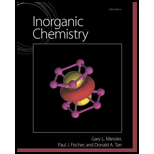
Concept explainers
Explain the following:
a. Ethylene,
b.
c. Of the compounds mercury(ll) cyanate,
Want to see the full answer?
Check out a sample textbook solution
Chapter 3 Solutions
Inorganic Chemistry
- List the major intermolecular forces of attraction (IMFs) which exists for the following molecules: A. NH3B. C2H6C. CO2-Classify the following compounds as ionic compounds, nonpolar or polar molecules. Justify your answer. (O 3.44; Cl 3.16; Br 2.96; C 2.55; H 2.20; S 2.58; Ca 1.0).A. CO2B. CaBr2C. CCl4arrow_forward1. lewis structure of Cesium 2-hydroxyacetate, HOCH2CO2Cs 2. assign the VSEPR model of the central atom3. Value of the corresponding theoretical angle4. classify 3 of the different bonds around the central atom as ionic or covalent5. draw the complete 3-D structure with respect to the central atom (s)6. draw the lewis structure for another mnolecule or species with a different atomic arrangementarrow_forward5.a. Explain how the lattice energy of an ionic compound such as KCI can be determined using the Born-Haber cycle. On what law is this procedure based? How do the ionization energy and the electron affinity determine whether atoms of elements will combine to form ionic compounds? b. Explain in molecular orbital terms the changes in H-H inter-nuclear distance that occurs as the molecular H2 is ionized first to H2* and then to H2²*. Explain why the bond order of N2 is greater than that of N2*, but the bond order of 02 is less than that of O2*.arrow_forward
- Describe how the bond angles in TeF4 and BRF5 deviate from those found in a trigonal bipyramidal and an octahedron, respectively. In TeF4, the lone pair of electrons repels the Te-F bonding pairs, causing the F-Te-F angles to be smaller than v in the ideal trigonal bipyramid. In BrF5, the lone pair is located perpendicular v to the plane of four of the F atoms, giving a square pyramid v geometry to the molecule. The angle between the four E in the plane and the F above the plane will be less than v 90° due to lone pair repulsion. The F-Br-F angles in the plane will remain DEC étv MacBook Air DD F4 F5 F6 F7 F8 F9 F10 F2 F3 @ # 2$ 3 4 6. 8. S LOarrow_forward1. lewis structure of Trimethyl phosphite, (CH3O)3P 2. assign the VSEPR model of the central atom3. Value of the corresponding theoretical angle4. classify 3 of the different bonds around the central atom as ionic or covalent5. draw the complete 3-D structure with respect to the central atom (s)6. draw the lewis structure for another mnolecule or species with a different atomic arrangementarrow_forward2. Explain the following: a. Ethylene, C₂H4, is a planar molecule, but hydrazine, N₂H₂, is not. b. ICl, is linear, but NH₂ is bent. c. Of the compounds mercury (II) cyanate, Hg(OCN)2, and mercury(II) fulminate, Hg(CNO)2, one is highly explosive, and the other is not.arrow_forward
- b) Answer the following question and give a brief explanation for your answers. a. Which one is more reactive : cesium, Cs or potassium, K? Explain b. Which one is more electronegative silicon, Si or tellurium, Te? Explain c. Arrange the following according to their size : smallest to largest. Justify your answer. O2 , F, Nearrow_forwardWhy is Br3SiH distorted from the expected 109.5o tetrahedral bond angle, while SiBr4 is not?arrow_forwardThe molecular structure of NCI 3 is A. pyramidal O B. bent C. none of these O D. octahedral O E. trigonal planararrow_forward
- Consider bonding in elemental oxygen and elemental sulfur. a.Why is O2 more stable as a diatomic molecule than S2? b.Why does S8 form much more stable ring structure than O8?arrow_forwardAn unknown gas, D, reacts with fluorine gas to form the compound DF4 (g), as represented by the following equation: D(g) + 2F 2 (g) --> DF4 (g) C. A student claims that if element D is in group 18, then the molecular geometry of DF4 (g) is tetrahedral. Do you agree? Justify in terms of VSEPR.arrow_forward14:41 x Which one of the following statements is correct? A. All metals are shiny and can conduct electricity. B. Metalloids are referred to as semiconductors. C. Density of metals are the opposite of non-metals, while metalloids have no density. D. Non-metals are used as conductors because they do conduct well. 5문 • T Which one of the following statements is correct: The name of As2O3 is arsenic trioxide. The name of O²- is an oxygen ion. The name of Fe2(SO4)3 is Iron (III) sulfite. The name of MnO4 is permanganate. A. B. C. D. Which one of the following statements regarding quantum numbers and shells is correct? A. The primary quantum number, n, can have a number of 1.5. B. A subshell p can hold 6 electrons. C. n = 2 can have the following subshells: s, s and p. D. A d subshell can have 3 orbitals. Which one of the following least describes something related to the periodic table? A. Noble gas elements B. Alkali metals C. Alkynes D. Halides Add a caption... 4G Ò > Status (Custom)arrow_forward
 ChemistryChemistryISBN:9781305957404Author:Steven S. Zumdahl, Susan A. Zumdahl, Donald J. DeCostePublisher:Cengage Learning
ChemistryChemistryISBN:9781305957404Author:Steven S. Zumdahl, Susan A. Zumdahl, Donald J. DeCostePublisher:Cengage Learning Chemistry: An Atoms First ApproachChemistryISBN:9781305079243Author:Steven S. Zumdahl, Susan A. ZumdahlPublisher:Cengage Learning
Chemistry: An Atoms First ApproachChemistryISBN:9781305079243Author:Steven S. Zumdahl, Susan A. ZumdahlPublisher:Cengage Learning
 Chemistry & Chemical ReactivityChemistryISBN:9781133949640Author:John C. Kotz, Paul M. Treichel, John Townsend, David TreichelPublisher:Cengage Learning
Chemistry & Chemical ReactivityChemistryISBN:9781133949640Author:John C. Kotz, Paul M. Treichel, John Townsend, David TreichelPublisher:Cengage Learning



